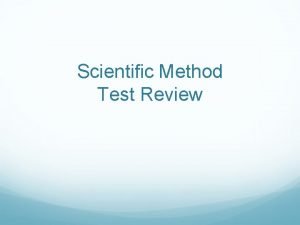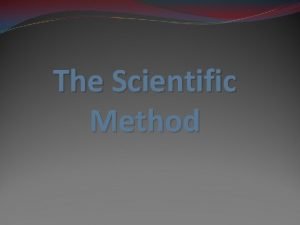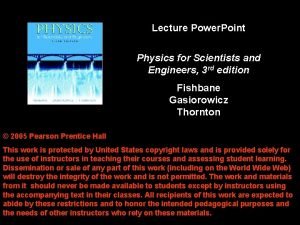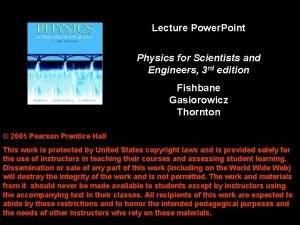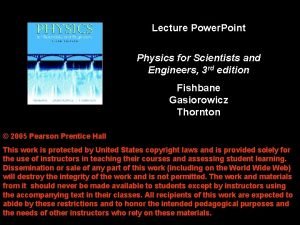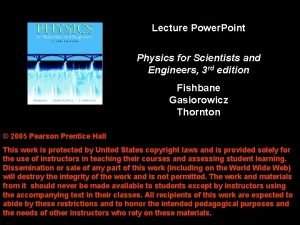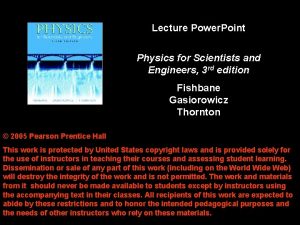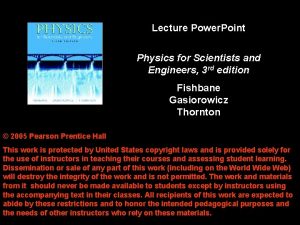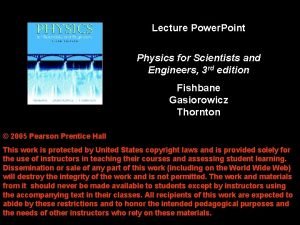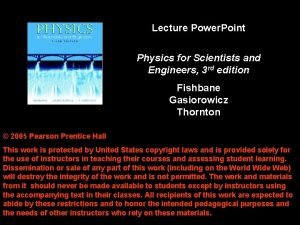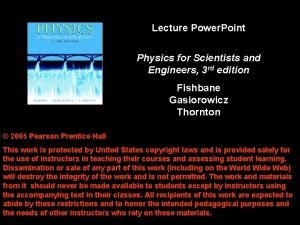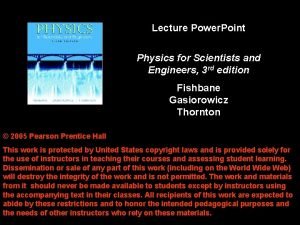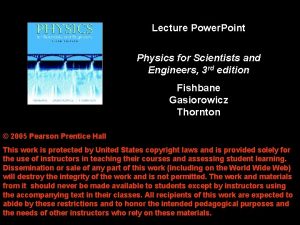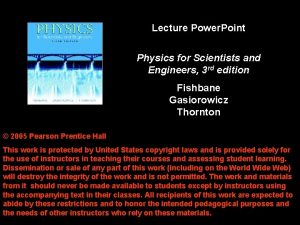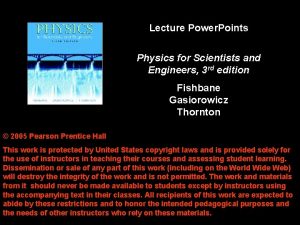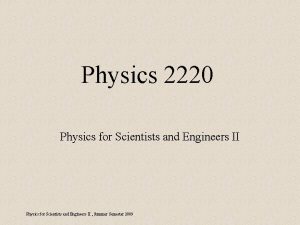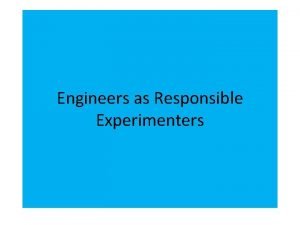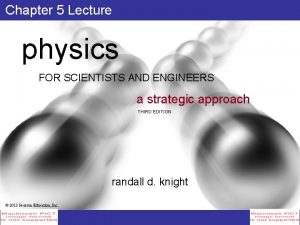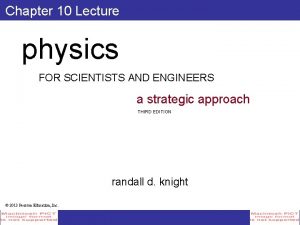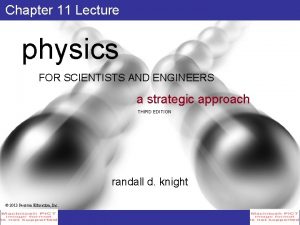Lecture Power Point Physics for Scientists and Engineers




















- Slides: 20

Lecture Power. Point Physics for Scientists and Engineers, 3 rd edition Fishbane Gasiorowicz Thornton © 2005 Pearson Prentice Hall This work is protected by United States copyright laws and is provided solely for the use of instructors in teaching their courses and assessing student learning. Dissemination or sale of any part of this work (including on the World Wide Web) will destroy the integrity of the work and is not permitted. The work and materials from it should never be made available to students except by instructors using the accompanying text in their classes. All recipients of this work are expected to abide by these restrictions and to honor the intended pedagogical purposes and the needs of other instructors who rely on these materials.

Chapter 11 Statics

Main Points of Chapter 11 • Static conditions for rigid bodies • Independence of conditions with respect to origin of coordinate system • Gravity and rigid bodies • Applications of statics • Underdetermined systems • Solids and how they respond to forces • Stress, strain

11 -1 Static Conditions for Rigid Bodies • Only external forces will determine stability of rigid object – ignore crumbling, flexing, etc • If object is static (not moving), there is no net force on it, and no net torque around any axis

11 -1 Static Conditions for Rigid Bodies • Condition of no torque doesn’t depend on reference point – if an object has no torque around a particular point, and doesn’t have any linear acceleration, it will not have torque around any other point either.

11 -1 Static Conditions for Rigid Bodies Force equilibrium condition: (11 -3) Torque equilibrium condition: (11 -4)

11 -2 Gravity and Rigid Bodies Gravity acts as though it were applied to a concentrated (point) mass equal to the total mass M at the center of mass of the extended object. In figure below, the object is stable in (a) and (b), as the center of mass is over the table, but in (c) it will fall – there is a net torque on it.

11 -3 Applications of Statics Problem-solving techniques for statics problems: • Prepare extended free-body diagram of object in question, showing all forces and where they act • Choose origin and coordinate system to make torque calculation as easy as possible • Choose a direction for positive torque

11 -3 Applications of Statics Problem-solving techniques for statics problems (cont): • Write down statics conditions – vector sum of forces is zero, as is vector sum of torques • Count equations to make sure there as many equations as unknowns • Solve algebraically – don’t plug in numbers until you have a solution

11 -3 Applications of Statics Underdetermined systems If there are more unknowns than constraint equations, system is underdetermined Example: four-legged table Only three equations for the four normal forces – need another piece of information to solve, such as symmetry or weight distribution

11 -4 Solids and How They Respond to Forces Crystal lattice structure: • atoms oscillate around equilibrium positions • modeling interatomic force as spring is helpful: • Simplest lattice structure is simple cubic:

11 -4 Solids and How They Respond to Forces Crystal defects: slight misplacement of a single atom can throw off crystal structure The image on the left is perfect; the image on the right has a defect. Can you find it?

11 -4 Solids and How They Respond to Forces Grain boundaries: places where lattices of different orientations meet On the left: a model using bubbles On the right: a real crystal

11 -4 Solids and How They Respond to Forces Stretching Compression Shear

11 -4 Solids and How They Respond to Forces Definition of stress: Response to stress is compressional strain: Here, e is dimensionless. It is negative for compression and positive for tension. (11 -16) (11 -17)

11 -4 Solids and How They Respond to Forces Relationship between stress and strain: (11 -19) Y is Young’s modulus, a characteristic of the material. Young’s moduli vary widely:

11 -4 Solids and How They Respond to Forces When a solid is compressed in one direction, it tends to bulge in the others; when it is under tension the other directions tend to shrink. How much bulging or shrinking is characteristic of the material, and is described by Poisson’s ratio σ: (11 -18)

11 -4 Solids and How They Respond to Forces Shear forces will deform object: Bulk modulus describes volume change under compression or tension: (11 -20) Negative sign means that inward force tends to decrease volume.

11 -4 Solids and How They Respond to Forces Tensile strength is the pressure that will cause material to fracture – strain at fracture is called critical strain: Tensile strengths very widely with material, and even with direction within the material

Summary of Chapter 11 • Rigid object is static when net force and net torque are zero • Gravitational force acts at the center of mass • Interatomic forces in solids are springlike • In response to external forces, solids will stretch, shrink, or deform; Young’s modulus and tensile strength describe properties of solids
 01:640:244 lecture notes - lecture 15: plat, idah, farad
01:640:244 lecture notes - lecture 15: plat, idah, farad Draw power triangle
Draw power triangle Power bi power point
Power bi power point Point point power
Point point power Power system dynamics and stability lecture notes
Power system dynamics and stability lecture notes Power system dynamics and stability lecture notes
Power system dynamics and stability lecture notes Physics 111 lecture notes
Physics 111 lecture notes What is a harmonic wave in physics
What is a harmonic wave in physics Physics 101 lecture 1
Physics 101 lecture 1 Physics 101 lecture notes pdf
Physics 101 lecture notes pdf Physics waves notes pdf
Physics waves notes pdf Atmospheric physics lecture notes
Atmospheric physics lecture notes Zline 667-36
Zline 667-36 Power semiconductor devices lecture notes
Power semiconductor devices lecture notes Switch mode power supply lecture notes
Switch mode power supply lecture notes Traditions in things fall apart
Traditions in things fall apart Hub and spoke system advantages and disadvantages
Hub and spoke system advantages and disadvantages Sometimes scientists make a mistake or
Sometimes scientists make a mistake or Diagrams tables and graphs are used by scientists mainly to
Diagrams tables and graphs are used by scientists mainly to Why does it happen
Why does it happen University physics with modern physics fifteenth edition
University physics with modern physics fifteenth edition

















